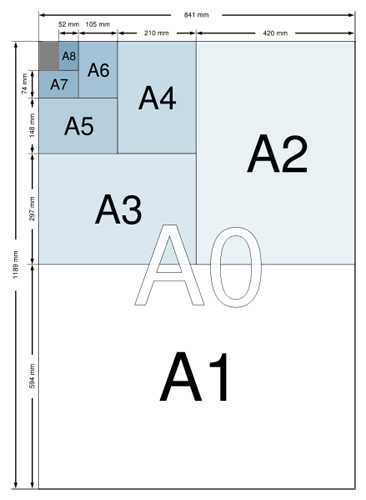 |
| ISO A Series Paper Sizes |
The ISO (International Standards Organisation) 'A series' of paper sizes has become the global standard for document sizes, it based is based on the following principles:
- A0 has an area of one square metre.
- The height divided by the width of all formats is the square root of two (1.4142).
- A1 is A0 cut into two equal pieces. In other words, the height of A1 is the width of A0 and the width of A1 is half the height of A0. All smaller A series formats are defined in the same way.
- If you cut format An parallel to its shorter side into two equal pieces of paper, these will have format A(n+1).
- The standardized height and width of the paper formats is a rounded number of millimeters.
In the ISO paper size system, the height-to-width ratio of all pages is the square root of two (1.4142 : 1). In other words, the width and the height of a page relate to each other like the side and the diagonal of a square. This aspect ratio is especially convenient for a paper size. If you put two such pages next to each other, or equivalently cut one parallel to its shorter side into two equal pieces, then the resulting page will have the same width/height ratio. This is especially useful in the creation of brochures, booklets, newsletters and magazines.
 |
| ISO B Series Paper Sizes |
For publications where the ISO A series does not provide an adequate format, the B series has been introduced to cover a wider variety of paper sizes. The C series of formats has been defined for envelopes.
 |
| ISO C Series Paper Sizes |
The following table shows the width and height of all ISO A and B paper formats, as well as the ISO C envelope formats. All dimensions are in millimeters (mm):
| A Series Formats | B Series Formats | C Series Formats | |||
| 4A0 | 1682 x 2378 | - | - | - | - |
| 2A0 | 1189 x 1682 | - | - | - | - |
| A0 | 841 x 1189 | B0 | 1000 x 1414 | C0 | 917 x 1297 |
| A1 | 594 x 841 | B1 | 707 x 1000 | C1 | 648 x 917 |
| A2 | 420 x 594 | B2 | 500 x 707 | C2 | 458 x 648 |
| A3 | 297 x 420 | B3 | 353 x 500 | C3 | 324 x 458 |
| A4 | 210 x 297 | B4 | 250 x 353 | C4 | 229 x 324 |
| A5 | 148 x 210 | B5 | 176 x 250 | C5 | 162 x 229 |
| A6 | 105 x 148 | B6 | 125 x 176 | C6 | 114 x 162 |
| A7 | 74 x 105 | B7 | 88 x 125 | C7 | 81 x 114 |
| A8 | 52 x 74 | B8 | 62 x 88 | C8 | 57 x 81 |
| A9 | 37 x 52 | B9 | 44 x 62 | C9 | 40 x 57 |
| A10 | 26 x 37 | B10 | 31 x 44 | C10 | 28 x 40 |
The ISO standard paper size system covers a wide range of formats, but not all of them are widely used. Among all formats, A4 is the most commonly used. Examples of common publications and the paper sizes they utilise are documented below.
The main advantage of the ISO standard paper sizes becomes evident when using copier machines. Copier machines designed for ISO paper sizes usually provide special keys for frequently needed magnification factors based on the ISO sizes, this allows the user to easliy scale the original ,up or down, to a size better suited to their needs.
| Paper Size(s) | Publications/Applications |
| A0, A1 | technical drawings, large posters |
| A1, A2 | flip charts |
| A2, A3 | drawings, diagrams, large tables, small posters |
| A4 | letters, magazines, forms, catalogs, laser printer and copying machine output |
| A5 | note pads |
| A6 | postcards |
| B5, A5, B6, A6 | books |
| C4, C5, C6 | envelopes for A4 letters: unfolded (C4), folded once (C5), folded twice (C6) |
| B4, A3 | newspapers, supported by most copying machines in addition to A4 |
| B8, A8 | playing cards |
If you found this useful you might also enjoy our article on the most common file types.



















